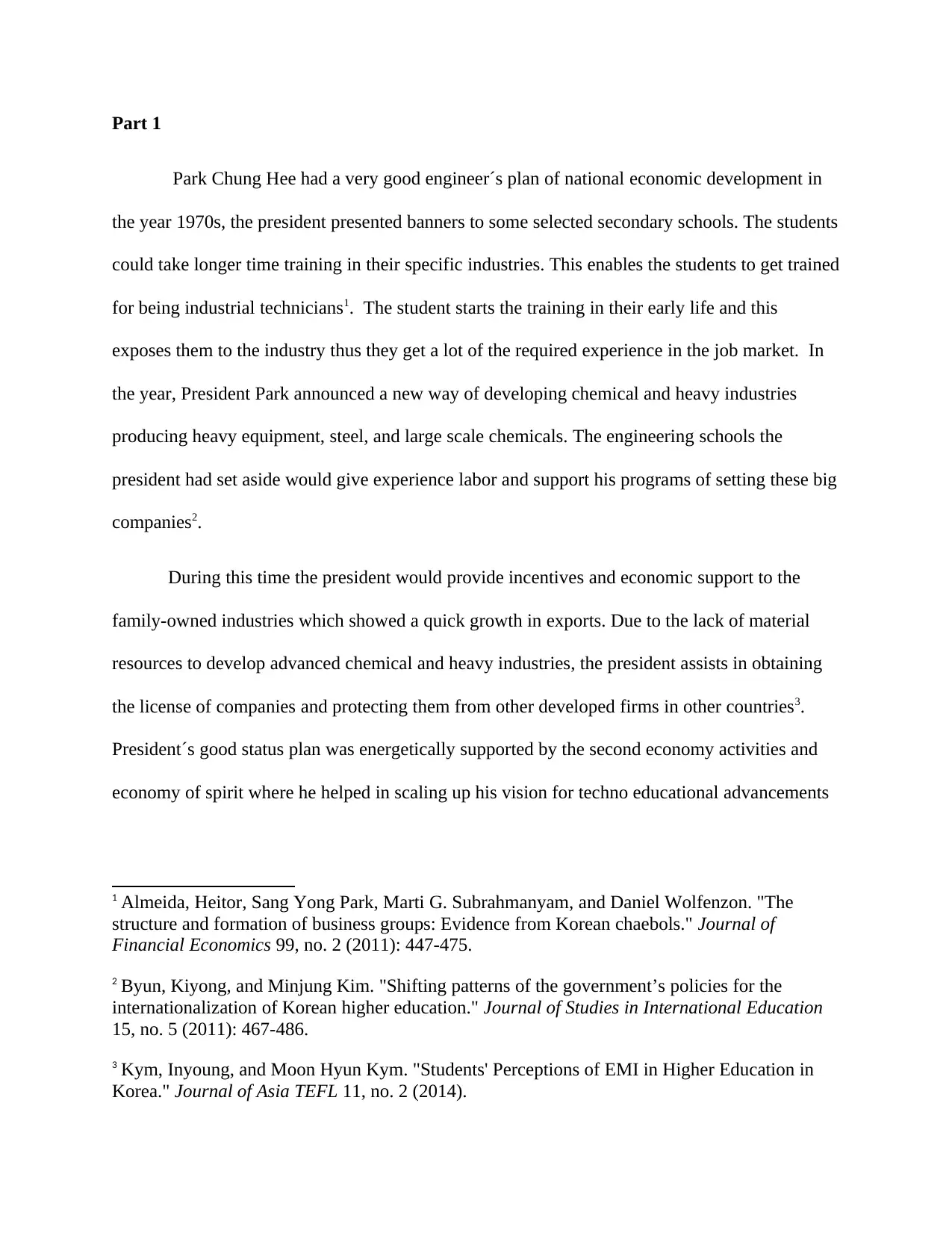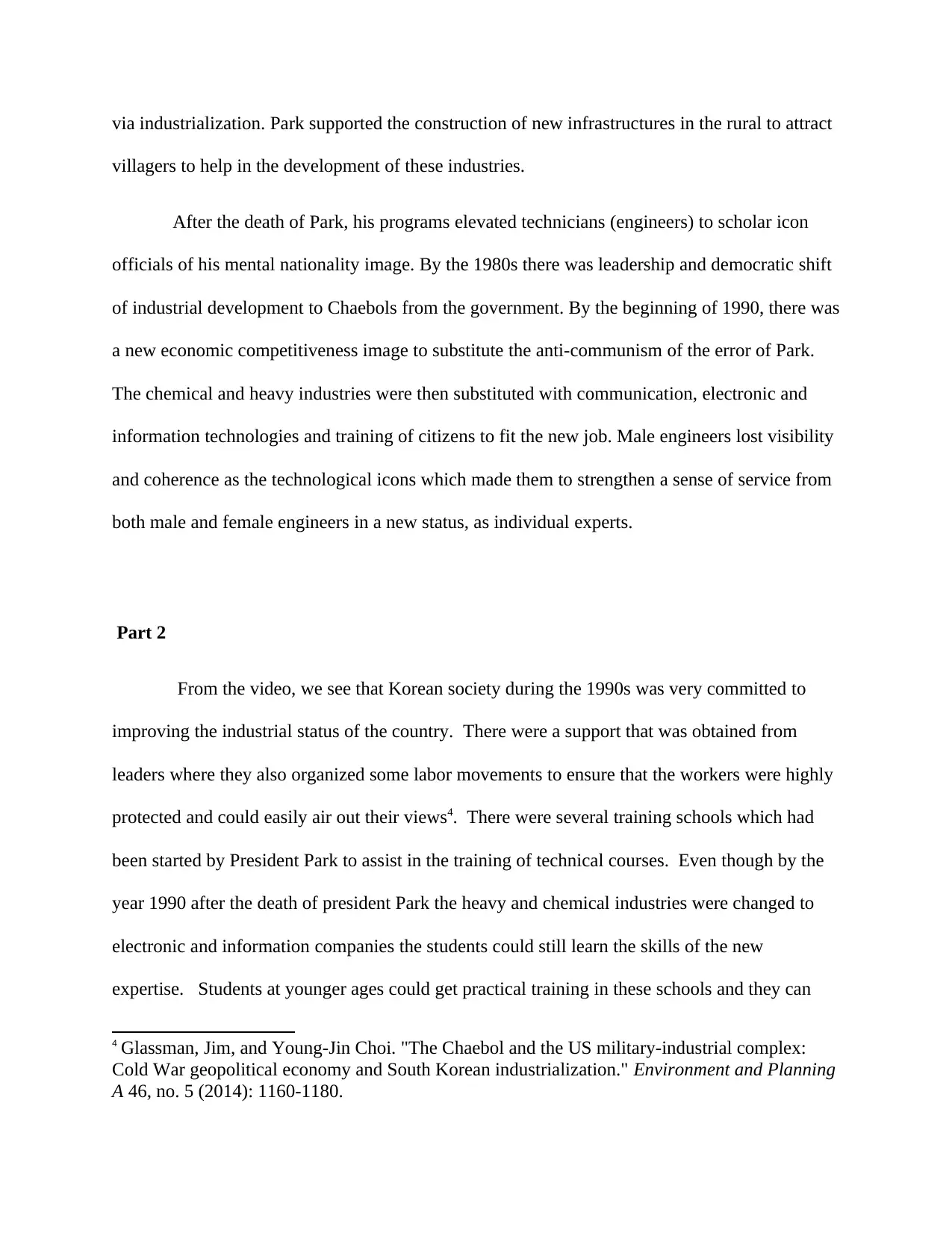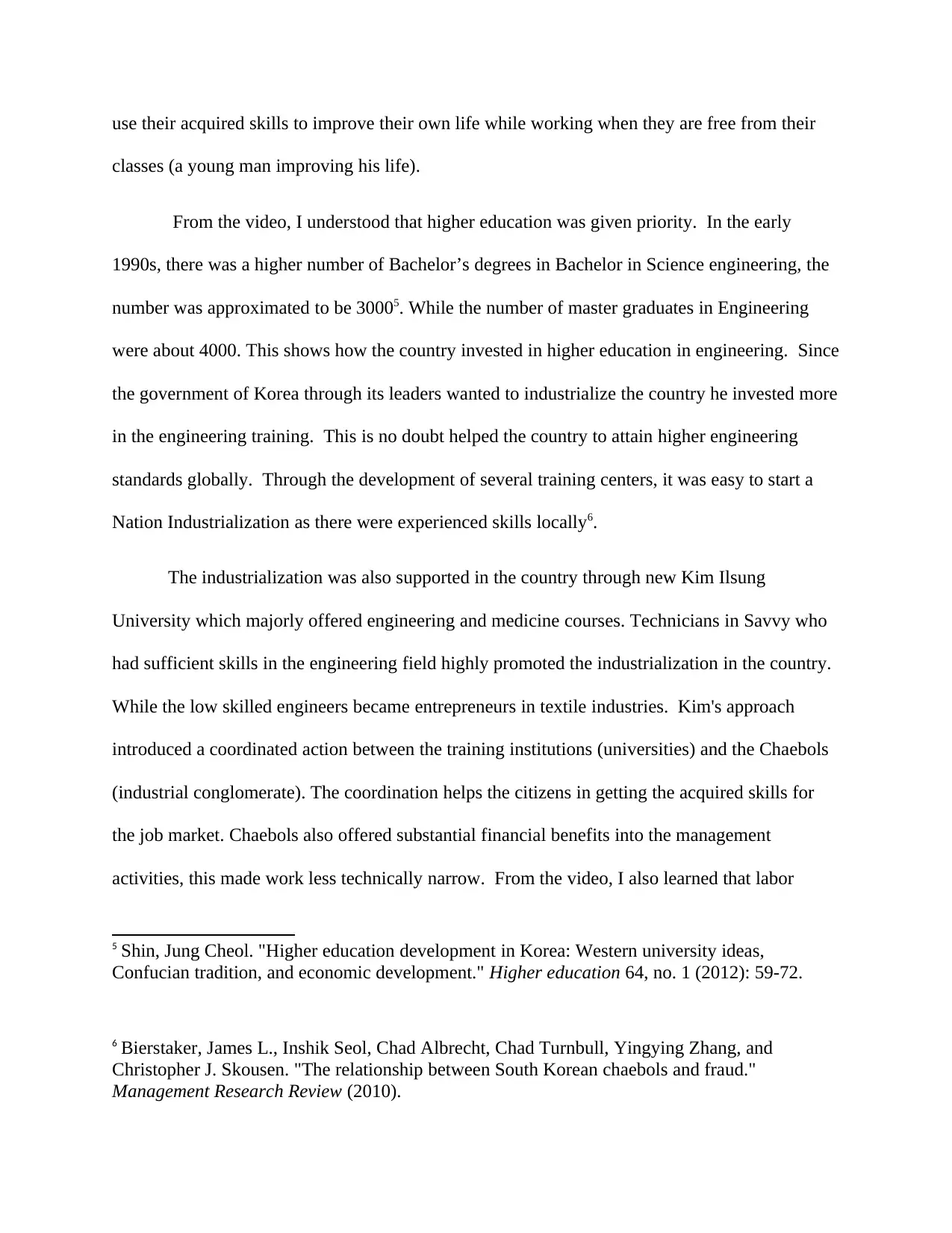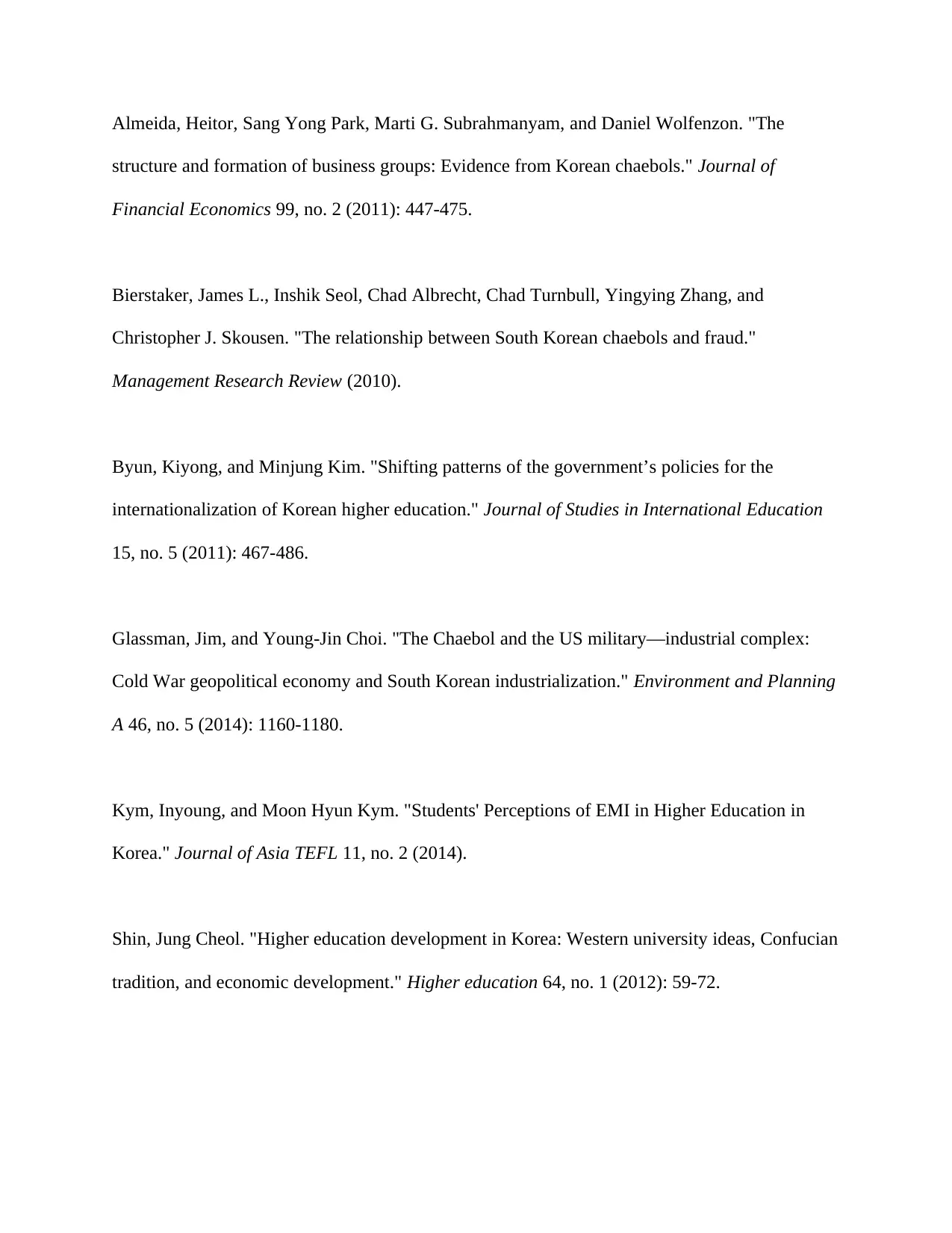Analysis of Engineering Cultures: Korea's Industrialization Report
VerifiedAdded on 2022/10/15
|6
|1036
|18
Report
AI Summary
This report examines the evolution of engineering culture in South Korea, focusing on the industrial development initiatives under Park Chung Hee and the subsequent shifts in the 1980s and 1990s. It highlights the president's strategic plans, including the establishment of engineering schools and incentives for family-owned industries, which facilitated the growth of chemical and heavy industries. The report discusses the transition from government-led industrial development to the rise of Chaebols and the shift towards communication, electronic, and information technologies. It also analyzes the emphasis on higher engineering education and the role of labor movements in improving working conditions. The analysis is supported by references to academic sources, providing a comprehensive overview of South Korea's engineering and industrial transformation.

ENGINEERING CULTURES
By Name
Course
Instructor
Institution
Location
Date
By Name
Course
Instructor
Institution
Location
Date
Paraphrase This Document
Need a fresh take? Get an instant paraphrase of this document with our AI Paraphraser

Part 1
Park Chung Hee had a very good engineer´s plan of national economic development in
the year 1970s, the president presented banners to some selected secondary schools. The students
could take longer time training in their specific industries. This enables the students to get trained
for being industrial technicians1. The student starts the training in their early life and this
exposes them to the industry thus they get a lot of the required experience in the job market. In
the year, President Park announced a new way of developing chemical and heavy industries
producing heavy equipment, steel, and large scale chemicals. The engineering schools the
president had set aside would give experience labor and support his programs of setting these big
companies2.
During this time the president would provide incentives and economic support to the
family-owned industries which showed a quick growth in exports. Due to the lack of material
resources to develop advanced chemical and heavy industries, the president assists in obtaining
the license of companies and protecting them from other developed firms in other countries3.
President´s good status plan was energetically supported by the second economy activities and
economy of spirit where he helped in scaling up his vision for techno educational advancements
1 Almeida, Heitor, Sang Yong Park, Marti G. Subrahmanyam, and Daniel Wolfenzon. "The
structure and formation of business groups: Evidence from Korean chaebols." Journal of
Financial Economics 99, no. 2 (2011): 447-475.
2 Byun, Kiyong, and Minjung Kim. "Shifting patterns of the government’s policies for the
internationalization of Korean higher education." Journal of Studies in International Education
15, no. 5 (2011): 467-486.
3 Kym, Inyoung, and Moon Hyun Kym. "Students' Perceptions of EMI in Higher Education in
Korea." Journal of Asia TEFL 11, no. 2 (2014).
Park Chung Hee had a very good engineer´s plan of national economic development in
the year 1970s, the president presented banners to some selected secondary schools. The students
could take longer time training in their specific industries. This enables the students to get trained
for being industrial technicians1. The student starts the training in their early life and this
exposes them to the industry thus they get a lot of the required experience in the job market. In
the year, President Park announced a new way of developing chemical and heavy industries
producing heavy equipment, steel, and large scale chemicals. The engineering schools the
president had set aside would give experience labor and support his programs of setting these big
companies2.
During this time the president would provide incentives and economic support to the
family-owned industries which showed a quick growth in exports. Due to the lack of material
resources to develop advanced chemical and heavy industries, the president assists in obtaining
the license of companies and protecting them from other developed firms in other countries3.
President´s good status plan was energetically supported by the second economy activities and
economy of spirit where he helped in scaling up his vision for techno educational advancements
1 Almeida, Heitor, Sang Yong Park, Marti G. Subrahmanyam, and Daniel Wolfenzon. "The
structure and formation of business groups: Evidence from Korean chaebols." Journal of
Financial Economics 99, no. 2 (2011): 447-475.
2 Byun, Kiyong, and Minjung Kim. "Shifting patterns of the government’s policies for the
internationalization of Korean higher education." Journal of Studies in International Education
15, no. 5 (2011): 467-486.
3 Kym, Inyoung, and Moon Hyun Kym. "Students' Perceptions of EMI in Higher Education in
Korea." Journal of Asia TEFL 11, no. 2 (2014).

via industrialization. Park supported the construction of new infrastructures in the rural to attract
villagers to help in the development of these industries.
After the death of Park, his programs elevated technicians (engineers) to scholar icon
officials of his mental nationality image. By the 1980s there was leadership and democratic shift
of industrial development to Chaebols from the government. By the beginning of 1990, there was
a new economic competitiveness image to substitute the anti-communism of the error of Park.
The chemical and heavy industries were then substituted with communication, electronic and
information technologies and training of citizens to fit the new job. Male engineers lost visibility
and coherence as the technological icons which made them to strengthen a sense of service from
both male and female engineers in a new status, as individual experts.
Part 2
From the video, we see that Korean society during the 1990s was very committed to
improving the industrial status of the country. There were a support that was obtained from
leaders where they also organized some labor movements to ensure that the workers were highly
protected and could easily air out their views4. There were several training schools which had
been started by President Park to assist in the training of technical courses. Even though by the
year 1990 after the death of president Park the heavy and chemical industries were changed to
electronic and information companies the students could still learn the skills of the new
expertise. Students at younger ages could get practical training in these schools and they can
4 Glassman, Jim, and Young-Jin Choi. "The Chaebol and the US military-industrial complex:
Cold War geopolitical economy and South Korean industrialization." Environment and Planning
A 46, no. 5 (2014): 1160-1180.
villagers to help in the development of these industries.
After the death of Park, his programs elevated technicians (engineers) to scholar icon
officials of his mental nationality image. By the 1980s there was leadership and democratic shift
of industrial development to Chaebols from the government. By the beginning of 1990, there was
a new economic competitiveness image to substitute the anti-communism of the error of Park.
The chemical and heavy industries were then substituted with communication, electronic and
information technologies and training of citizens to fit the new job. Male engineers lost visibility
and coherence as the technological icons which made them to strengthen a sense of service from
both male and female engineers in a new status, as individual experts.
Part 2
From the video, we see that Korean society during the 1990s was very committed to
improving the industrial status of the country. There were a support that was obtained from
leaders where they also organized some labor movements to ensure that the workers were highly
protected and could easily air out their views4. There were several training schools which had
been started by President Park to assist in the training of technical courses. Even though by the
year 1990 after the death of president Park the heavy and chemical industries were changed to
electronic and information companies the students could still learn the skills of the new
expertise. Students at younger ages could get practical training in these schools and they can
4 Glassman, Jim, and Young-Jin Choi. "The Chaebol and the US military-industrial complex:
Cold War geopolitical economy and South Korean industrialization." Environment and Planning
A 46, no. 5 (2014): 1160-1180.
⊘ This is a preview!⊘
Do you want full access?
Subscribe today to unlock all pages.

Trusted by 1+ million students worldwide

use their acquired skills to improve their own life while working when they are free from their
classes (a young man improving his life).
From the video, I understood that higher education was given priority. In the early
1990s, there was a higher number of Bachelor’s degrees in Bachelor in Science engineering, the
number was approximated to be 30005. While the number of master graduates in Engineering
were about 4000. This shows how the country invested in higher education in engineering. Since
the government of Korea through its leaders wanted to industrialize the country he invested more
in the engineering training. This is no doubt helped the country to attain higher engineering
standards globally. Through the development of several training centers, it was easy to start a
Nation Industrialization as there were experienced skills locally6.
The industrialization was also supported in the country through new Kim Ilsung
University which majorly offered engineering and medicine courses. Technicians in Savvy who
had sufficient skills in the engineering field highly promoted the industrialization in the country.
While the low skilled engineers became entrepreneurs in textile industries. Kim's approach
introduced a coordinated action between the training institutions (universities) and the Chaebols
(industrial conglomerate). The coordination helps the citizens in getting the acquired skills for
the job market. Chaebols also offered substantial financial benefits into the management
activities, this made work less technically narrow. From the video, I also learned that labor
5 Shin, Jung Cheol. "Higher education development in Korea: Western university ideas,
Confucian tradition, and economic development." Higher education 64, no. 1 (2012): 59-72.
6 Bierstaker, James L., Inshik Seol, Chad Albrecht, Chad Turnbull, Yingying Zhang, and
Christopher J. Skousen. "The relationship between South Korean chaebols and fraud."
Management Research Review (2010).
classes (a young man improving his life).
From the video, I understood that higher education was given priority. In the early
1990s, there was a higher number of Bachelor’s degrees in Bachelor in Science engineering, the
number was approximated to be 30005. While the number of master graduates in Engineering
were about 4000. This shows how the country invested in higher education in engineering. Since
the government of Korea through its leaders wanted to industrialize the country he invested more
in the engineering training. This is no doubt helped the country to attain higher engineering
standards globally. Through the development of several training centers, it was easy to start a
Nation Industrialization as there were experienced skills locally6.
The industrialization was also supported in the country through new Kim Ilsung
University which majorly offered engineering and medicine courses. Technicians in Savvy who
had sufficient skills in the engineering field highly promoted the industrialization in the country.
While the low skilled engineers became entrepreneurs in textile industries. Kim's approach
introduced a coordinated action between the training institutions (universities) and the Chaebols
(industrial conglomerate). The coordination helps the citizens in getting the acquired skills for
the job market. Chaebols also offered substantial financial benefits into the management
activities, this made work less technically narrow. From the video, I also learned that labor
5 Shin, Jung Cheol. "Higher education development in Korea: Western university ideas,
Confucian tradition, and economic development." Higher education 64, no. 1 (2012): 59-72.
6 Bierstaker, James L., Inshik Seol, Chad Albrecht, Chad Turnbull, Yingying Zhang, and
Christopher J. Skousen. "The relationship between South Korean chaebols and fraud."
Management Research Review (2010).
Paraphrase This Document
Need a fresh take? Get an instant paraphrase of this document with our AI Paraphraser

movements organized by the leaders improved the work environment and ensured that the rights
of the employees were highly protected.
References
of the employees were highly protected.
References

Almeida, Heitor, Sang Yong Park, Marti G. Subrahmanyam, and Daniel Wolfenzon. "The
structure and formation of business groups: Evidence from Korean chaebols." Journal of
Financial Economics 99, no. 2 (2011): 447-475.
Bierstaker, James L., Inshik Seol, Chad Albrecht, Chad Turnbull, Yingying Zhang, and
Christopher J. Skousen. "The relationship between South Korean chaebols and fraud."
Management Research Review (2010).
Byun, Kiyong, and Minjung Kim. "Shifting patterns of the government’s policies for the
internationalization of Korean higher education." Journal of Studies in International Education
15, no. 5 (2011): 467-486.
Glassman, Jim, and Young-Jin Choi. "The Chaebol and the US military—industrial complex:
Cold War geopolitical economy and South Korean industrialization." Environment and Planning
A 46, no. 5 (2014): 1160-1180.
Kym, Inyoung, and Moon Hyun Kym. "Students' Perceptions of EMI in Higher Education in
Korea." Journal of Asia TEFL 11, no. 2 (2014).
Shin, Jung Cheol. "Higher education development in Korea: Western university ideas, Confucian
tradition, and economic development." Higher education 64, no. 1 (2012): 59-72.
structure and formation of business groups: Evidence from Korean chaebols." Journal of
Financial Economics 99, no. 2 (2011): 447-475.
Bierstaker, James L., Inshik Seol, Chad Albrecht, Chad Turnbull, Yingying Zhang, and
Christopher J. Skousen. "The relationship between South Korean chaebols and fraud."
Management Research Review (2010).
Byun, Kiyong, and Minjung Kim. "Shifting patterns of the government’s policies for the
internationalization of Korean higher education." Journal of Studies in International Education
15, no. 5 (2011): 467-486.
Glassman, Jim, and Young-Jin Choi. "The Chaebol and the US military—industrial complex:
Cold War geopolitical economy and South Korean industrialization." Environment and Planning
A 46, no. 5 (2014): 1160-1180.
Kym, Inyoung, and Moon Hyun Kym. "Students' Perceptions of EMI in Higher Education in
Korea." Journal of Asia TEFL 11, no. 2 (2014).
Shin, Jung Cheol. "Higher education development in Korea: Western university ideas, Confucian
tradition, and economic development." Higher education 64, no. 1 (2012): 59-72.
⊘ This is a preview!⊘
Do you want full access?
Subscribe today to unlock all pages.

Trusted by 1+ million students worldwide
1 out of 6
Your All-in-One AI-Powered Toolkit for Academic Success.
+13062052269
info@desklib.com
Available 24*7 on WhatsApp / Email
![[object Object]](/_next/static/media/star-bottom.7253800d.svg)
Unlock your academic potential
Copyright © 2020–2025 A2Z Services. All Rights Reserved. Developed and managed by ZUCOL.


